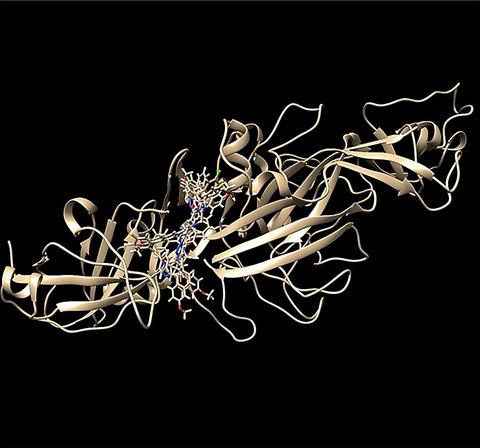当前位置:
X-MOL 学术
›
Mol. Oral Microbiol.
›
论文详情
Our official English website, www.x-mol.net, welcomes your feedback! (Note: you will need to create a separate account there.)
Identification of functional domains of the minor fimbrial antigen involved in the interaction of Porphyromonas gingivalis with oral streptococci.
Molecular Oral Microbiology ( IF 3.7 ) Pub Date : 2020-02-13 , DOI: 10.1111/omi.12280 Mohammad Roky 1, 2 , John O Trent 3 , Donald R Demuth 1, 2
Molecular Oral Microbiology ( IF 3.7 ) Pub Date : 2020-02-13 , DOI: 10.1111/omi.12280 Mohammad Roky 1, 2 , John O Trent 3 , Donald R Demuth 1, 2
Affiliation

|
Porphyromonas gingivalis is associated with chronic periodontitis and may initially colonize the oral cavity by adhering to streptococci. Adhesion to streptococci is driven by interaction of the minor fimbrial antigen (Mfa1) with streptococcal antigen I/II. We identified the region of antigen I/II required for this interaction and developed small molecule mimetics that inhibited P. gingivalis adherence. However, the functional motifs of Mfa1 involved in the interaction with antigen I/II remain uncharacterized. A series of N‐ and C‐terminal peptide fragments of Mfa1 were expressed and tested for inhibition of P. gingivalis adherence to S. gordonii. This approach identified residues 225–400 of Mfa1 as essential for P. gingivalis adherence. Using the three‐dimensional structure of Mfa1, a putative binding cleft was identified using SiteMap and five small molecule mimetics could dock in this site. Site‐specific mutation of residues in the predicted cleft, including R240A, W275A, D321A and A357P inhibited the interaction of Mfa1 with streptococci, whereas mutation of residues not in the predicted cleft (V238A, I252F and ΔK253) had no effect. Complementation of an Mfa1‐deficient P. gingivalis strain with wild‐type mfa1 restored adherence to streptococci, whereas complementation with full‐length mfa1 containing the R240A or A357P mutations did not restore adherence. The mutations did not affect polymerization of Mfa1, suggesting that the complemented strains produced intact minor fimbriae. These results identified specific residues and structural motifs required for the Mfa1‐antigen I/II interaction and will facilitate the design of small molecule therapeutics to prevent P. gingivalis colonization of the oral cavity.
中文翻译:

鉴定涉及牙龈卟啉单胞菌与口服链球菌相互作用的次要纤维抗原的功能域。
牙龈卟啉单胞菌与慢性牙周炎有关,可能最初通过粘附于链球菌而定居在口腔中。次要纤维抗原(Mfa1)与链球菌抗原I / II的相互作用驱动链球菌的粘附。我们确定了这种相互作用所需的抗原I / II区域,并开发了抑制牙龈卟啉单胞菌粘附的小分子模拟物。但是,参与与抗原I / II相互作用的Mfa1的功能基序仍未表征。表达了一系列Mfa1的N和C末端肽片段,并测试了其对牙龈卟啉单胞菌对戈登酵母的粘附的抑制作用。该方法确定了Mfa1的225–400残留物对牙龈卟啉单胞菌至关重要坚持。使用Mfa1的三维结构,使用SiteMap鉴定了一个假定的结合裂口,五个小分子模拟物可以停泊在该位点。R240A,W275A,D321A和A357P等预测裂口中残基的位点特异性突变抑制了Mfa1与链球菌的相互作用,而预测裂口中的残基突变(V238A,I252F和ΔK253)则没有作用。Mfa1缺陷型牙龈卟啉单胞菌菌株与野生型mfa1的互补可恢复对链球菌的依从性,而全长mfa1的互补可恢复包含R240A或A357P突变的基因不能恢复依从性。突变不会影响Mfa1的聚合,表明互补的菌株产生完整的次要菌毛。这些结果确定了Mfa1-抗原I / II相互作用所需的特定残基和结构基序,将有助于小分子治疗剂的设计,以防止牙龈卟啉单胞菌在口腔中定植。
更新日期:2020-02-13
中文翻译:

鉴定涉及牙龈卟啉单胞菌与口服链球菌相互作用的次要纤维抗原的功能域。
牙龈卟啉单胞菌与慢性牙周炎有关,可能最初通过粘附于链球菌而定居在口腔中。次要纤维抗原(Mfa1)与链球菌抗原I / II的相互作用驱动链球菌的粘附。我们确定了这种相互作用所需的抗原I / II区域,并开发了抑制牙龈卟啉单胞菌粘附的小分子模拟物。但是,参与与抗原I / II相互作用的Mfa1的功能基序仍未表征。表达了一系列Mfa1的N和C末端肽片段,并测试了其对牙龈卟啉单胞菌对戈登酵母的粘附的抑制作用。该方法确定了Mfa1的225–400残留物对牙龈卟啉单胞菌至关重要坚持。使用Mfa1的三维结构,使用SiteMap鉴定了一个假定的结合裂口,五个小分子模拟物可以停泊在该位点。R240A,W275A,D321A和A357P等预测裂口中残基的位点特异性突变抑制了Mfa1与链球菌的相互作用,而预测裂口中的残基突变(V238A,I252F和ΔK253)则没有作用。Mfa1缺陷型牙龈卟啉单胞菌菌株与野生型mfa1的互补可恢复对链球菌的依从性,而全长mfa1的互补可恢复包含R240A或A357P突变的基因不能恢复依从性。突变不会影响Mfa1的聚合,表明互补的菌株产生完整的次要菌毛。这些结果确定了Mfa1-抗原I / II相互作用所需的特定残基和结构基序,将有助于小分子治疗剂的设计,以防止牙龈卟啉单胞菌在口腔中定植。



























 京公网安备 11010802027423号
京公网安备 11010802027423号